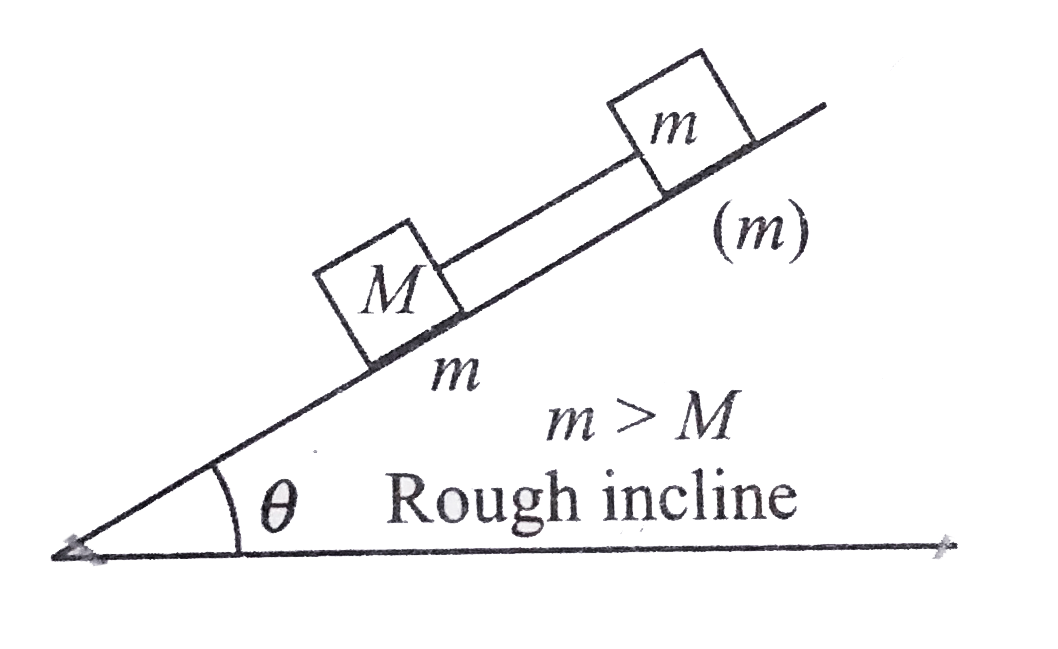A man is pulling a rope attached to a block on a smooth horizontal table. The tension in the rope will be the same at all points
if and only if the rope is not accelerated
if and only if the rope is massless
if either the rope is not accelerated or is massless
always
The correct Answer is:C
The tension in the rope will be same at all points if it is massless or if the string has mass, the tension will be the same in the string when it is not accelerating.
Topper's Solved these Questions
- NEWTONS LAWS OF MOTION AND FRICTIONBOOK - BITSAT GUIDECHAPTER - NEWTONS LAWS OF MOTION AND FRICTIONEXERCISE - BITSAT Archives
23 Videos
- MOTION IN !,2,2 DIMENSIONS AND POJECTILE MOTIONBOOK - BITSAT GUIDECHAPTER - MOTION IN !,2,2 DIMENSIONS AND POJECTILE MOTIONEXERCISE - All Questions
86 Videos
- ROTATIONAL MOTIONBOOK - BITSAT GUIDECHAPTER - ROTATIONAL MOTIONEXERCISE - BITSAT Archives
9 Videos
Similar Questions
A pull of 15 N is applied to a rope attached to a block of mass 7 kg lying on a smooth horizontal surface. The mass of the rope is 0.5 kg. What is the force exerted by the block on the rope?
View SolutionA monkey of mass 'm' climbs up to a rope hung over a fixed pulley with an acceleration g/4. The opposite end of the rope is tied to a block of mass M lying on a rough horizontal plane. The coefficient of friction between the block and horizontal plane is μ. Find the tension in the rope.

View Solution
Knowledge Check
STATEMENT-1: A block is pulled along a horizontal frictionless surface by a thick rope. The tension in the rope will not always be the same at all points on it.
because
STATEMENT-2: the tension in the rope depends on the acceleration of the block rope system and the mass of the rope.AStatement-1 is true, Statement-2 is True, Statement -2 is a correct explanation for Statement-1.BStatement-1 is True, Statement-2 is True, Statement -2 is NOT a correct explanation for Statement-1.CStatement-1 is True, Statement-2 is False.DStatement - 1 is False, Statement -2 is True.A rope of length L has its mass per unit langth λ varies according to the function λ(x)=ex/L. The rope is pulled by a constant force of 1 N on a smooth horizontal surface. The tension in the rope at x=L/2 is :
 A0.50 NB0.38 NC0.62 NDNone
A0.50 NB0.38 NC0.62 NDNoneIn figure the tension in the rope (rope is light) is
 A(M+m)gsinθB(M+m)gsinθ−μmgcosθCZeroD(M+m)gsinθ
A(M+m)gsinθB(M+m)gsinθ−μmgcosθCZeroD(M+m)gsinθ
A rope of length 10m and linear density 0.5kg/m is lying length wise on a smooth horizontal floor It is pulled by a force of 25N. The tension in the rope at a point 6m away from the point of application is .
View SolutionA rope of length 10m and linear density 0.5kg/m is lying length wise on a smooth horizontal floor. It is pulled by a force of 25 N. The tension in the rope at a point 6m away from the point of application is
View SolutionA cat of mass m = 1 kg climbs to a rope hung over a leight frictionless pulley. The opposite end of the rope is tied to a weight of mass M = 2m lying on a smooth horizontal plane. What is the tension of the rope where the cat move upwards with in acceleration a=2m/s2 relative to the rope ?

View SolutionA rope of length 5 m has uniform mass per unit length. λ=2kgm The rope is pulled by a constant force of 10N on the smooth horizontal surface as shown in figure The tension in the rope at x = 2 m from polit A is
View SolutionA uniform rope of length l and mass m lies on a smooth horizontal table with its length perpendicular to the edge of the table and a small part of the rope having over the edge. The rope starts sliding from rest under the weight of the over hanging end. The velocity of the rope when the length of the hanging part is . x
View Solution
